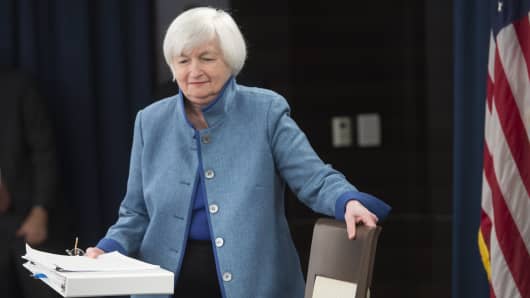The portion of the Federal Open Market Committee statement on the economy wasn’t that different from the one released in November. They reaffirmed the continued improvement in the labor market. They did acknowledge the rise in inflation expectations within the TIPS market by saying they “moved up considerably but still are low.” Considering that the 10 year expectation is at the Fed’s desired 2 percent I’m not sure why they still think that is low.
They repeated again that they expect “that economic conditions will evolve in a manner that will warrant only gradual increases in the fed funds rate” and that it is “likely to remain, for some time, below levels that are expected to prevail in the longer run.” No belief here in “When the facts change, I change my mind.”
Reading the statement one has to wonder that maybe they were asleep on November 8th when Donald Trump was elected the president. They barely raised their 2017 GDP forecast to 2.1 percent from 2 percent and did not change at all their 2018 estimate of 2 percent.
It sure doesn’t seem like they modeled a new tax and regulatory regime. They did not change at all their inflation forecasts. Thus, no calculation whatsoever that fiscal reform/stimulus will have any impact on economic growth and inflation.
Maybe acknowledging this missing view, Janet Yellen in her press conference did say that the committee discussed Trump and his possible growth initiatives but because of the uncertainty over what might get implemented they decided to wait to change their own assumptions.
Noteworthy, but not that relevant, is the dot plot where the new fed funds projection for 2017 is one quarter point higher than the previous forecast. The dots now predict a 1.375 percent fed funds rate at the end of 2017 vs 1.125 percent before.
The short end of the yield curve is spiking as a result and the yield curve is flattening as a result. Just a reminder though, in December 2015 when the FOMC first hiked rates, the dot plot had the fed funds rate at 1.375 percent at the end of 2016 and 2.375 percent by the end of 2017.
Bottom line, the Fed is many corners behind the curve. After all, we are entering our 8th year of this expansion and the fed funds rate is only at .625 percent. Their econometric models have latched on to this concept of the ‘neutral rate’ which is another way of rationalizing their gradual pace of rate hikes.
But, the world is changing, accelerated by the election and this patience in rate normalization has finally caught up to them. The markets are thus tightening policy for the Fed. The Fed therefore has two choices: 1) Follow through and raise rates more aggressively in 2017 and get control back from the bond market or 2) Continue to drag their feet and let the bond market run them over by doing it for them
source”cnbc”

